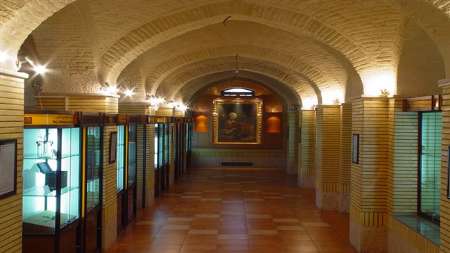
It is not only the country’s largest museum of history and archeology, but also ranks as one of the few most prestigious museums of the world in view of its grand dimension, diversity and quality of the artifacts, Tehran-based English newspaper, Iran Daily, reported.
It is considered as Iran’s mother museum, which aims to preserve the ancient relics for the coming generations, improve understanding among world peoples and nations, and enhance public knowledge.
This modest museum is not Louvre, but it represents Iran’s rich history. Designed by French architect André Godard and completed in 1928, it is one of the most attractive buildings in Tehran, blending Sassanid architecture such as the eivan-style entrance with art deco–style brickwork.
The interior includes a collection of ceramics, potteries, stone figures and carvings, mostly taken from excavations at Persepolis (Fars province) , Ismail Abad (near Qazvin), Shoush (Khuzestan province) , Rey (Tehran province) and Turang Tappeh (Golestan province).
Among the findings from Shoush, there is a stone capital of a winged lion, some delightful pitchers and vessels in animal shapes, and colorful glazed bricks decorated with double-winged mythical creatures. A copy of the diorite stele, detailing the Babylonian Code of Hammurabi — found at Shoush in 1901 — is also displayed. The original one is in Paris.
The ancient objects from Persepolis include a magnificent human-headed capital; a cuneiform inscription proclaiming the might and godly affinity of Xerxes; and a striking frieze of glazed tiles from the central hall of Apadana Palace.
Also, following objects are on display:
A famous trilingual inscription from the time of Darius I; a bull-headed capital and carved staircase; a statue of a sitting dog that looks like it was carved just weeks ago; and four foundation tablets inscribed in cuneiform.
One of the more startling exhibits is Salt Man from Zanjan. He is believed to have been a miner who died in the Third or Fourth Century CE. More comical is a bronze statue of Parthian prince ‘Shami’ found in Khuzestan province, whose cheesy moustache looks out from a head obviously made separately from the much larger body.
There is also an impressive selection of Lorestan bronzes, which date back to the Eighth Century BCE.
A small cafe is located in a courtyard behind the museum.
The National Museum of Iran and Azarbaijan Museum in Tabriz are considered the oldest museums of Iran.

Add new comment